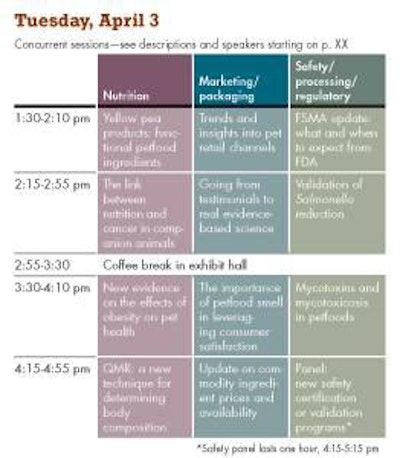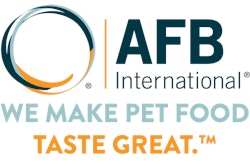
The global petfood industry continues to grow, thanks to continuing humanization of pets. Make sure you’re keeping up with the latest consumer trends and needs—plus all you need to know about pet nutrition and petfood packaging, safety and processing—by attending Petfood Forum 2012 and Petfood Workshop: New Product Development.
Scheduled for April 2-4 at the Renaissance Schaumburg near Chicago, Illinois, USA, Petfood Forum kicks off with opening keynote speaker Betsy Banks Saul, founder and president of Petfinder.com, sharing what she has learned from pets, pet owners and partners like petfood companies during the 15 years her organization has been helping pets find homes. (Plus, pets from Petfinder.com’s member shelters in the area will drop by to visit her presentation.)
The conference ends with closing keynote Michael Taylor, deputy commissioner of foods for the US Food and Drug Administration, explaining how petfood safety fits into the overall food safety picture and what the new Food Safety Modernization Act means for smaller producers.
In between, you can learn from dozens of other industry experts, network and catch up with colleagues, meet new industry professionals and do business with leading suppliers in the exhibit hall, which will be bigger than ever.
Immediately following on April 4-5, Petfood Workshop: New Product Development focuses on one of the drivers of our industry’s continued growth—innovation—and how you can improve that process within your company. Find more information.
Following is the schedule, speakers and topics for Petfood Forum as of press time. For updates, bookmark www.petfoodindustry.com/PFF2012.aspx and watch for the March issue.
Monday, April 2
12:00-6:30 pm Exhibitor set-up
12:00-7:30 pm Registration/check-in
5:30-7:30 pm Opening reception
Tuesday, April 3
7:30-8:30 am Breakfast
8:30-9:30 am Keynote: Betsy Banks Saul, founder and president of Petfinder.com, which bills itself as the oldest and largest searchable directory of adoptable pets on the Web and serves as a portal to over 13,000 animal shelters and adoption groups around the US and Canada.
9:30 am-6:30 pm Exhibit hall open
9:30-10:30 am General session: Consumer insights from the pet e-commerce channel—Jon Roska Jr., founder of PetFoodDirect.com and VP of merchandising for Pet360, shares what he’s learned about pet owners who buy, rate and search for petfood online.
10:30-11:00 am Coffee break in exhibit hall/visit with pets from Petfinder.com member shelters
11:00 am-12 pm Time in exhibit hall/visit with shelter pets
12:00-1:30 pm Lunch
1:30-4:55 pm Concurrent sessions—see descriptions and speakers, also see Table 1
2:55-3:30 pm Coffee break in exhibit hall
4:55-6:30 pm Reception in exhibit hall
5:45-6:30 pm Poster reception in exhibit hall annex
Wednesday, April 4
7:30-8:30 am Breakfast
8:30 am-12 pm Exhibit hall open
8:30-11:55 am Concurrent sessions—see descriptions and speakers, also see Table 2
9:55-10:30 am Coffee break in exhibit hall
12-1:15 pm Closing keynote/lunch: Michael Taylor, JD, deputy commissioner for foods for FDA and the person overseeing all food safety policy and regulation for the US, addresses similarities and differences between human food safety and petfood safety and new rules arising from FSMA.
12-10 pm Exhibit hall tear-down
Descriptions and speakers for Petfood Forum concurrent sessions
Nutrition
Yellow pea products: functional petfood ingredients —Gary Lynch, PhD, senior project coordinator with Roquette, describes the fractioning of yellow peas by wet milling process as a relatively new source of ingredients with applications such as a protein for texturization, a highly digestible source of amino acids, purified pea starch for grain-free formulations and a binder for meat chunks in wet petfood.
The link between nutrition and cancer in companion animals —Elizabeth P. Ryan, PhD, assistant professor with the Animal Cancer Center at Colorado State University, describes the limited but promising research on the role nutrition may play in preventing and controlling canine and feline cancer.
New evidence on the effects of obesity on pet health and the role of manufacturers in pet obesity prevention —Jennifer Adolphe, RD, MSc, PhD candidate at the University of Saskatchewan Western College of Veterinary Medicine, discusses recent research on the negative health effects of obesity in pets, how it can be applied to formulating weight control diets and the role of petfood manufacturers in the treatment and prevention of obesity.
QMR: a new technique for determining body composition —Howard Dobson, VP of R&D for CanCog Technologies, describes a new technology, quantitative magnetic resonance, that can help determine proportions of fat and lean tissue and total body water in dogs and cats.
An in vitro procedure for comparing fiber sources in dog foods —Marie Varloud, PhD, scientist with In Vivo NSA, explains a method for studying fiber digestion and fermentation by canine microbiota; this can help in selecting a fiber source for a formulation.
Particle size effect on feline palatability, processing and more —Kristopher Figge, senior scientist for AFB International, provides details of research that evaluate the potential effects of kibble particle size on feline palatability, production energy usage and texture.
Optimal nutrition for canine athletes —Matt Panasevich, graduate research assistant, University of Illinois Department of Animal Sciences, explains how to formulate performance diets with the goal of providing an ideal ratio of macronutrients to maximize energy usage from both anaerobic and aerobic metabolic pathways; he focuses on research with Greyhounds.
Innovations in treats and nutritional enhancements for small mammals —Micah Kohles, DVM, director of technical services for Oxbow Animal Health, presents the latest research on nutrition needs and trends for small mammal pets other than cats and dogs.
Marketing/packaging
Trends and insights in pet retail channels —David Lummis, senior pet market analyst for Packaged Facts, provides an update on the US petfood market, with a focus on pet retail channels: Which ones are gaining or giving up ground?
Going from testimonials to real evidence-based science —Roger Clemens, PhD, president of the Institute of Food Technologists and chief scientific officer for ET Horn, stresses the importance of using evidence-based scientific information in making label claims while presenting products to the market and balancing the science with marketing needs and demands.
The importance of petfood smell in leveraging consumer satisfaction —Chloe Champion, markets and trends manager for SPF, and Mark Rubin, senior flavorist for Firmenich, present new research on what pet-owning consumers think about the smell of kibble and its impact on perceived quality and value in today’s marketplace.
Update on commodity ingredient prices and availability —Susan Sutherland, associate director of Agricultural Products for the CME Group, and Bob Bresnahan, CEO of Trilateral, a purchasing and risk management advisor for businesses depending on commodities and related ingredients, will share short- and long-term projections and recommendations for dealing with the commodity market’s volatility.
Petfood banks: an emerging industry partner —John Kane, director of the Rescue Bank, a nationwide coalition of petfood banks and pantries, provides information on how petfood companies can use the food bank model to enhance their brands, communicate nutritional awareness and dispel myths.
Consumer goods packaging trends and the importance of effective packaging communications —James Fraser and Matthew Diamond, partners with Hunter Straker, a purchase design agency in Canada, share consumer behavior insights on what does—and doesn’t—communicate effectively on packaging, as well as examples of trends.
How to arrest the ingredient cost assault on your brand value proposition —Robert Wheatley, CEO of Wheatley & Timmons, offers an antidote to stress on your brand created by pricing challenges and helps you lock into distinctions that separate your business from every other brand on the shelf.
Petfood brands and social media —Bruce Plantz, VP/director of content, and Kathleen McLaughlin, social media editor, of Watt Publishing present exclusive data and insights on how petfood brands and companies are being followed, commented on and highlighted through Twitter and other social media. They will also share best practices in using social media to gain awareness and engagement for your brand.
Safety/regulatory/processing
Impact of FSMA on regulation of petfood —Daniel McChesney, PhD, director of the Office of Surveillance & Compliance, Center for Veterinary Medicine, Food and Drug Administration, provides specifics and timelines for new regulations coming from the Food Safety Modernization Act and what they mean for your company.
Validation of Salmonella reduction —Michael Hayes, director of food safety & quality for Del Monte Foods, presents research on validating the reduction of Salmonella in heat-processed, low-moisture foods.
Mycotoxins and mycotoxicosis in petfoods —Duarte E. Diaz, PhD, feed quality technical manager for Novus, provides solutions to some of the most common problems with mycotoxins, including sampling.
Panel: new safety certification or validation programs —members include the National Animal Supplement Council (Bill Bookout, president); Extru-Tech Inc.’s (Will Henry, director of technology R&D); and the American Feed Industry Association (Leah Wilkinson, director of ingredients and state legislative affairs).
New nutritional guidelines and labeling codes for petfoods in Europe —Thomas Meyer, secretary general of the European Pet Food Industry Federation, describes nutritional guidelines and a labeling code recently released by FEDIAF, plus other EU updates.
Cross-contamination prevention and controls —James V. Giranda, VP of food safety and quality systems for American Nutrition, explains cross-contamination and how to ensure safe petfood products.
Validation of extrusion temperature as a CCP in the petfood process —Galen Rokey, process manager for Wenger Manufacturing, shares results of recent studies indicating the correlation of extrusion temperature and moisture with destruction of pathogenic organisms in an inoculated petfood recipe, serving as a critical control point.
Technologies for Salmonella reduction: focus on topical treatment —Carl Knueven, corporate director of R&D for Jones-Hamilton Co., reviews new methods of reducing Salmonella in petfood and shares research on using sodium bisulfate as a topical treatment.
Petfood Workshop: New Product Development
Bookmark www.petfoodindustry.com/Workshop2012.aspx for updates.
Wednesday, April 4
12:00-2:00 pm Registration/check-in
2:00-3:00 pm Opening keynote: New research on ways to jump-start innovation and improve chances of new product success —Vicki Gardner, senior VP of product innovation for Nielsen North America, shares 12 tasks every new initiative must do well to be successful. This assessment approach to innovation, called Nielsen BASES Factors for Success, is an industry first, Nielsen says, designed to comprehensively evaluate new product initiatives against consumer adoption through the lens of success.
3:00-3:20 pm Coffee break
3:20-4:35 pm First round of breakout sessions (each an interactive workshop; attendees rotate among the four rooms):
How to set and manage timelines and expectations —Greg Aldrich, PhD, president of Pet Food Ingredients & Technology, shares tips and insights on how to get the entire new product development team on the same schedule and agreeing to the same outcomes.
Idea generation —John Adams, president of Adams Development, explains techniques for generating new product ideas from all sources, plus best practices for evaluating the ideas to consider which ones merit development.
Balancing act: trade-offs among stakeholders —David Dzanis, DVM, PhD, DACVN, CEO of Regulatory Discretion Inc., advises on how to balance the competing formulation, marketing and regulatory demands, needs and issues.
Testing to take a product to market —Angele Thompson, PhD, president of Thompson Pet Tech, provides information on the various types of tests (feeding trials; palatability, product and market tests; focus groups; etc.) necessary to successfully launch a new product.
4:40-5:55 pm Second round of breakout sessions
6:00-7:00 pm Reception
Thursday, April 5
7:00-8:00 am Breakfast
8:00-9:15 am General session: Ask the experts panel —here’s your chance to ask anything and everything you’ve ever wanted to know about new product development. Panel members include George Collings, PhD, general manager of Nutrition Solutions; Micah Kohles, DVM, director of technical services for Oxbow Animal Health; Leigh Ann Sayen, president of the Peterson Co.; and Robert Stuckey, president of FoodSciProcessing. Check back as we confirm more panel members.
9:15-9:45 am Coffee break
9:45-11:00 am Third round of breakout sessions
11:05 am-12:20 pm Fourth round of breakout sessions

















